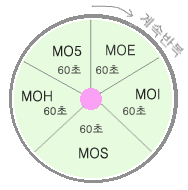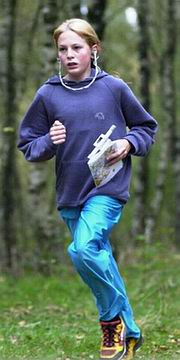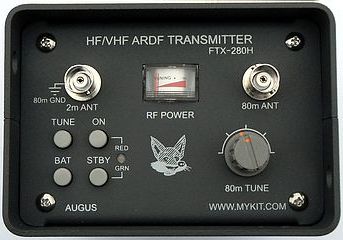|
|
전파
송신기(1분씩 5대 송신기가 반복하여 송신)를
찾는 경기
ARDF(무선방향탐지경기)는 누구나
즐길 수 있는 국민건강 스포츠
■ ARDF (Amateur Radio Direction Finding) 란? <전파를 이용하는 스포츠>
RDF(ARDF;Amateur Radio Direction Finding)는 우리말로 전파 방향 탐지 대회라고 부르며, 규칙에 따라 자유롭게 심신을 단련시킬 수 있는 스포츠적인 면과 가족, 친구 또는 이웃들과 함께 즐길 수 있는 오락적인 측면, 간단하지만 첨단기술로 제작된 기기로 전파를 이용하는 과학적인 측면이 함께 하는 신종 첨단 과학스포츠로서, 주로 숲이나 나무가우거진 들과 산에서 행하여지기 때문에 환경 친화적입니다. 이 경기는 일찍이 2차대전 이전에 영국과 독일의 아마추어 무선사들에 의하여 시작 되었으며, ARDF는 1954년도에 유고슬라비아에서 시작되어 현재 세계적으로 경기를 실시하고 있다. 무선을 이용하는 스포츠로 세계적으로 많은 사람들이 즐기고 있으며, 우리나라는 유고에서 열린 제3회 세계대회를 북한과 같이 참가한 것이 시초로 알려지고 있으며, 국내에 보급된 것은 1980년대 말 박영순(HL1IFM: 당시 한국아마추어무선연맹 이사, 현재 한국ARDF클럽회장)께서 국내에서 경기를 할 수 있도록 송·수신기를 기증 한것이 계기가 되어 국내에 보급이 시작되었으며, 국내 첫 공식경기는 1989년 가을 한국아마추어무선연맹에서 주최 한 것이 처음이며, 1999년에는 IARU Reg.Ⅲ 제3회가 논산에서 개최하기도 했다.
이 경기는 높지 않는 야산 등(등고선 표고가 200m이하)에 5개의 송신기를 숨겨놓고 정해진 시간동안 누가 많이 빨리 찾는가 하는 경기로 체력, 지도보는법과 나침반 사용법, 수신기의 감각등이 요구되며, 초보자도 쉽게 익힐 수 있다. 5개의 송신기가 1분씩 순서대로 송신이 되며, 경기종류에는 2가지로 단파(HF 3.5MHz), 초단파(VHF 144MHz) 경기가 있으며, 국내에서는 3.5MHz경기는 아직 보급중에 있으나 일본을 제외한 다른 나라에서는 3.5MHz경기가 더 많이 실시되고 있다.
이 ARDF는 송신기의 구분 신호를 모르스 코드를 사용하므로 처음에 시작은 아마추어 무선사들 이었으나 경기자는 수신만 하므로 남녀노소 구분없이 누구나(일반인) 즐길 수 있다. 사용되는 모르스 코드는 아주 간단한 부호로 초보자도 금방 익힐 수 있다
□ 사용되는 모르스 코드 (5개의 송신기{동일 주파수}가 1분씩 순차적으로 반복 송신)
|
|
모오스 코드 |
|
|
1번 송신기 |
━ ━ ━ ━ ━ * |
1분간
연속반복 |
|
2번 송신기 |
━ ━ ━ ━ ━ * * |
1분간
연속반복 |
|
3번 송신기 |
━ ━ ━ ━ ━ * * * |
1분간
연속반복 |
|
4번 송신기 |
━ ━ ━ ━ ━ * * * * |
1분간
연속반복 |
|
5번 송신기 |
━ ━ ━ ━ ━ * * * * * |
1분간
연속반복 |
|
|
Beacon |
━ ━ ━ ━ ━ |
연속반복 |
|
※ 뒤쪽의 단점( * ) 개수가 송신기 번호 |
|||
Beacon : MO
: 도착지 확인용으로 5개 송신기와 다른 주파수로 연속
송신한다.


5개의 송신기가 1분씩 순차적으로 반복 송신
(5분주기)
※
일부 나라에서는 7분주기로 송신기를 7개 사용 경기를 행하기도 하며
6번 송신기는 MON, 7번 송신기는
MOD를 사용한다.
6
; MON : ━
━ ━ ━ ━ ━ *
7 ; MOD
: ━
━ ━ ━ ━ ━ * *
■ RDF (ARDF)는 스포츠
전파를 이용하는 스포츠
자연과 함께 하는 국민건강 스포츠로서 점차 참여가 확대되고 있습니다.
■ RDF (ARDF) 경기방법
송신기
5대를 설치하고
도착점에는 Beacon이 주파수를 달리 하여 연속 송신하게 된다.
출발은 클라스가 다른 4명 정도를 5분간격으로 출발시킨다.
대개 경기 시간은 120분정도이고 경기장 조건에 따라 달리 하기도 한다.
| 클라스 |
구분 |
|
| Senior (OM) |
나이 제한 없음 |
5개의 송신기를 모두 찾아야함 |
| Old Timer (OT) |
40 이상 |
정해진 4개의 송신기를 찾아야함 |
| Veteran (VT) |
55세 이상 |
정해진 4개의 송신기를 찾아야함 |
| Wooman (YL) |
여자 |
정해진 4개의 송신기를 찾아야함 |
| Junier (JN) |
18세 이하 |
정해진 4개의 송신기를 찾아야함 |
| 초보자급 |
처음 시작하는 사람 |
정해진 2개 또는 3개의 송신기를 찾아야함 |
새로운 국제 규칙
|
Women (D) |
Men(M) |
Age |
|
D19 |
M19 |
19 and younger |
|
D21 |
M21 |
regardless of age |
|
D35 |
M40 |
35 / 40 and older |
|
D50 |
M50 |
50 and older |
|
|
M60 |
60 and older |
우천시에도 경기는 실시되므로 이에 대비하여야 한다.
■ RDF (ARDF)를 시작할때 준비할 도구들
| 주최측 |
1. |
송신기 6대 1조 ;
송신기 가능한 한 0:00분에 리세트 시킨다.(매5분, 10분에 1번 시작) |
|
|
2. |
포스트
마크(프리즘) 및 펀치 각5개 |
|
|
3. |
배포용
지도 (가능하면 자북표시
; 1:35,000 또느 그 이상의 축적을 가지고 컬러로 인쇄) |
|
|
4. |
선수용 등번호 및 출발, 도착점, 위험지역 통과 방지용 안내 라인 색선 |
|
|
5. |
모니터용 수신기 (3.5㎒/ 144㎒) 각 1대 |
|
|
6. |
출발용 시계(초단위 까지 표시 되는 시계) 및 시보기 |
|
|
|
|
| 경기자 |
1. |
수신기
: AM mode 안테나 일체형으로 이어폰도 준비 |
|
|
2. |
3.5MHz대용
: 3.510∼3.600MHz범위 수신가능, A1모드사용으로 BFO가 내장 |
|
|
3. |
144MHz대용
: 144.50∼144.80MHz범위 수신가능, A2모드사용 |
|
|
4. |
나침반 :
지도
받침판이 있으면 편리 |
|
|
5. |
기타 : 신분증(클래스 확인용), 간편복장, 우의(우천시), 가벼운 신발, 음료등 |
|
|
|
|
|
핸디트랜시버를
송신기로 |
■ 국제경기
- 제1회 세계대회를 유고에서
시작 후 2000년10월 중국에서 제10회 대회가 열림.
- 제11회 세계대회
2002년9월 슬로바키아에서 대회가 열릴 예정.
- IARU Reg.Ⅲ경기는 1993년 중국(북경)에서 1회, 1996년에는 호주(타운스빌)에서
2회가,
1999년에는 한국(논산)에서 3회가, 2001년
8월에는 4회가 몽고(울란바트로)에서
열리고
2003년에는 호주에서 5회가, 2005년에는 일본에서
열릴예정.
- 매년 전일본ARDF경기 때 한국,중국등 초청 했었으며,
몽고에서도 한국, 일본등 초청경기를 한적도 있음.
■ 국내경기
아마추어무선연맹
주최 전국대회가 거의 매년 열리고 있고, 전파감시국장배가 2000년 부터
열리고 있고, 매년 노원네트, 경기지부, 강원지부, 부산지부, 충북지부,
강원지부, 화순(한국통신 전남지부)등 전국 각지에서 경기가 열리고 있으며, 각
클럽등에서 수시로 연습경기를 하고 있다.
점점 경기가
자주 개최 되고 있으며 관심을 갖는 사람이 늘어나고있는 추세임
■ 2002년 경기일정
2002년도 경기일정

 경기중인 선수의 모습 (귀에는 이어폰을 왼손에는 지도와 3.5MHz수신기)
경기중인 선수의 모습 (귀에는 이어폰을 왼손에는 지도와 3.5MHz수신기)
이 복장이 이상적입니다.
Technical Specifications for Amateur Radio Direction Finding Equipment
1. Receivers
1.1 Receivers
and antennas of any type may be used by the competitors.
1.2 Any
receiver producing audible interference in the 3,5 MHz or 144 MHz
band at a distance of 10 meters or more shall not be used in the
competitions.
1.3 The International
Jury may require tests on any competitor's receiver prior to its
use in the competitions.
2. Transmitters
2.1 It
is the responsibility of the organising society to ensure that all
transmitters in use comply with the relevant radio regulations in
force in the country of operation with regard to their electric
parameters, identification and to their being operated only by duly
authorised operators.
2.2 All transmitters
within one competition shall have the same parameters and the same
antenna installation.
2.3 The frequency
of the beacon transmitter shall be significantly different from
the frequency of the other five transmitters.
2.4 When
not scheduled to be transmitting, neither transmitter nor its antenna
may radiate any RF energy.
2.5 Antennas
shall provide omnidirectional horizontal radiation patterns.
2.6 Specifications
for the 3.5 MHz transmitters:
· Carrier
frequency 3510 ... 3600
KHz
· Frequency stability better
than 50 ppm
· Undesired
products level conforming
to the national regulations
· Output
RF power 1 - 5 W
· Mode A1A
(keyed unmodulated carrier)
· Keying
speed 8 ... 12 WPM
· Antenna vertical
2.7 Specifications for the 144 MHz transmitters:
· Carrier
frequency 144.5 ... 144.80
MHz
· Frequency stability better
than 50 ppm
· Undesired
products level conforming
to the national regulations
· Effective
Radiated Power (ERP) 0,25 - 1 W
· Mode A2A
(keyed carrier modulated by AF tone or continuous carrier modulated
by keyed AF tone)
· Modulation
depth 75 +- 5%
· Keying
speed 8 ... 12 WPM
· Antenna
polarisation horizontal
· Antenna
height 2 ... 3 meters above ground level
3. Time-keeping
system
3.1 The
official competition time shall correspond to the official local
time.
3.2 Two independent time-keeping
systems, a primary and a secondary, shall be used.
3.3 The
maximum deviation of the clocks at the start and finish line is
ONE SECOND against the official time during the whole competition.
3.4
The maximum deviation
of the transmitting periods is FIVE SECONDS against the official
time during the whole competition. The maximum transmitting overlap
of two transmitters is FIVE SECONDS.
4. Other equipment
4.1 Any other equipment used by the organiser (service radio net, time-keeping system, computers, electronic marking devices etc.) shall not cause audible interference to competitors' receivers.
Transmitters
1. Transmitters used at IARU ARDF Championships shall meet the Technical Specifications for ARDF Equipment (see Appendix 1, section 2).
2. The antenna installation shall not be changed during the competition.
3. All transmitters including the beacon shall be well audible during the whole competition from the starting point, using a receiver of average sensitivity. All transmissions shall be monitored and recorded by the organiser.
4. Transmitters begin to operate after all receivers have been collected at the start. Transmitters shall remain operating until the end of the time limit of the last competitor. The beacon transmitter shall remain operating until all competitors have finished.
5. Transmitters shall operate on each band in the following sequence:
· finish
beacon sending code MO continuously
· transmitter
No.1 sending code
MOE in the first
minute
· transmitter
No.2 sending code
MOI in the second
minute
· transmitter
No.3 sending code
MOS in the third
minute
· transmitter
No.4 sending code
MOH in the fourth
minute
· transmitter
No.5 sending code
MO5 in the fifth
minute
- of the
5-minute cycle, starting at 0:00.
If the authorities of the organising society make any transmitter identification compulsory such identification can only be transmitted during the active minute.
6. Transmitters shall be searched for by each category as follows:
· M21
category shall search all five transmitters.
· M19
category shall not be scored for transmitter No. 3 (MOS)
· M40
category shall not be scored for transmitter No. 5 (MO5)
· M50
category shall not be scored for transmitter No. 2 (MOI)
· D19
category shall not be scored for transmitter No. 2 (MOI)
· D21
category shall not be scored for transmitter No. 4 (MOH)
· D35
category shall not be scored for transmitter No. 1 (MOE)
· D50
and M60 categories shall not be scored for two transmitters defined
by the siting referee.
7. The order in which competitors search for and discover the transmitters is entirely at their discretion.
8. The finish beacon shall be placed at the entrance of the finish corridor. It has no flag and marking device and need not be discovered and registered.
9. Transmitters No.1 through 5 shall be marked by a flag consisting of three squares 30 x 30 cm arranged in a triangular form. Each square shall be divided diagonally, one half being white and the other orange or red.
10. The flag shall be close to the transmitter antenna but not further away than 4 meters. The flag shall be visible to competitors when they reach the transmitter antenna.
11. To prove the passage of the competitors, there shall be at least two or more marking devices in the immediate vicinity of each flag.
13. Each transmitter must be easily recognizable by its code number (one to five), which shall be fixed to the flag for easy identification by the competitors. In case of competitions with transmitters working on two different frequency bands there must be another clear sign indicating the frequency band of the transmitter.
14. All transmitters shall be guarded. Normally each transmitter is attended by the transmitter operator and a member of International Jury.
15. The time at which each competitor finds a transmitter shall be recorded.


